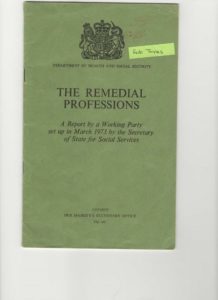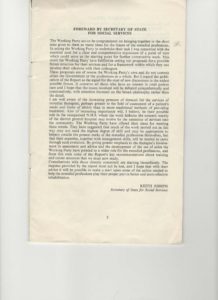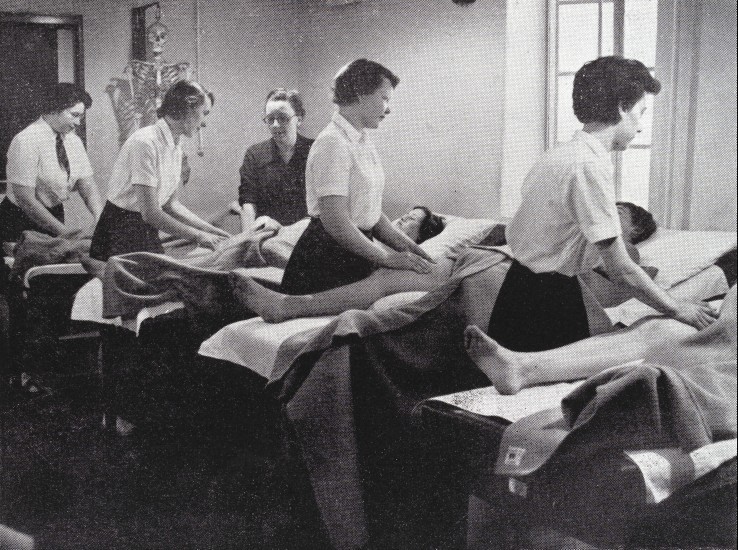A Watershed in Professional Independence in the UK – The McMillan Report
NOTE: Readers may be interested to know that Mr E.L. McMillan (Chairman of the McMillan working Party, in whose name the Report was published) was a patient of the author during the period that the working party was in process.
In 1973 a Government Working Party was set up by Sir Keith Joseph the then Secretary of State for Social Services to make recommendations on the future role of the then so-called remedial professions in relation to “Other professions and to the patient, and on the pattern of staffing and training needed to meet this.” (DHSS, 1973). Sir Keith asked that the recommendations should be made quickly.

The Working Party was chaired by a senior civil servant, Mr. E. L. McMillan, and was set up as a result of the great disappointment to the remedial professions, which resulted from the publication of the Tunbridge Report, (see RJJ article 3, August, 2020), and the “Statement by the Committee on the Remedial Professions, 1972”. At this time, Physiotherapy, Occupational Therapy and Remedial Gymnastics in the UK were known as the remedial professions. In 1972, Sir Keith Joseph had convened a meeting between himself and the remedial professions where the professions made it clear to him that they felt “grievously let down” by the previous committee reports and saw very little prospect of progress in the development of their professions or “proper recognition for skills and service they had to offer the community” (DHSS 1973 p3). As a result of this the McMillan working party was set up in 1973 and would become the basis for strengthening and expediting the process of professional autonomy for physiotherapy in the UK.


The Chartered Society of Physiotherapy, (CSP), The Association of Occupational Therapists and the Society of Remedial Gymnasts were each invited to nominate a member of their organisations to sit on the Working Party. These members were chosen by the professions because of their wide experience in the fields to be covered, they were not acting as “representatives” of their professions.
The full membership of the working party was:
- Mr. E. L. McMillan, (Chairman – Civil Servant)
- Dr. D. C. Ower – Department of Health and Social Security (DHSS)
- Mr. W. D. Paget – DHSS
- Mrs. S. E. Reeve – DHSS
- Mrs. J. M. Firth – DHSS
- Mr. J. H. C. Colson – Remedial Gymnast
- Miss L. E. Dyer – Chartered Physiotherapist
- Miss E. M. G. Grove – Occupational Therapist
- Mr. J. S. Tapsfield – Council for Professions Supplementary to Medicine.
It was the objective of the Working Party to make a fundamental appraisal of the role of the remedial professions in a modern service. The areas considered by them included:
(a) “Misuse and waste of professional skills”.
(b) “Dissatisfaction with career and salary structure”.
(c) “Shortage of trained therapists, (caused partly by (a and b) and worsened by an increased demand for their services, not at present matched by an increase in numbers of those qualifying”.
(d) “Inadequate support from clerical, secretarial and portering staff”.
(e) “Problems of overlapping of responsibilities, not only between the remedial professions themselves, but also between them and other professions, so that it is not always clear or understood, where responsibilities should lie” (DHSS, 1973 P7 and 8).
The Working Party recognised that in NHS hospitals the remedial professions had very limited managerial responsibilities associated with their clinical duties. The three professions were usually represented at management, policy-making and strategic levels by nursing or medical colleagues. Also McMillan acknowledged that senior members of the remedial professions “May organise their own departments, though often this is within a framework set by a consultant…such limitations are not conducive to the development of a feeling of responsibility” (DHSS 1973, p9). On the relationship between the remedial professions and the medical profession, McMillan acknowledged the doctor as the “key figure” in carrying primary responsibility for the patient. However, the Report spelled out clearly a concern that frequently this was interpreted as “requiring the doctor to prescribe and supervise in detail the therapy provided by the remedial professions” (DHSS 1973, p11).
In its criticism of these practices the Working Party noted that too often therapists were given insufficient scope to exercise their skills to the best possible advantage of the patient and “therapists are not trained to diagnose, nevertheless, experienced therapists can undoubtedly make a valuable contribution to diagnosis.” (DHSS, 1973 P11).
From these observations it was clear that the McMillan Working Party saw the remedial professions facing major clinical and managerial problems. They were still subordinate to the medical profession and were unable to manage their own services and use their skill and knowledge to the greatest possible effect. McMillan also drew attention to the scarce opportunities for management education and training, however, it was conceded that such opportunities were beginning to develop. The management limitations both in the clinical and organisational fields cited by the Working Party formed a major part of the document, and on this foundation a radical series of recommendations was laid which were to greatly influence the development of the three professions over the next ten years and form a clinical and managerial watershed for them.
The McMillan Report made recommendations on a wide range of issues including relationships with other professions, the medical profession and nursing, social workers and other staff concerned with remedial therapy, career structure, training and research. Many of the recommendations would have a profound effect on the organisation and management of physiotherapy services as well as on clinical practice. The clinical relationship between Chartered Physiotherapists and the medical profession would also be greatly influenced.
One important recommendation concerning the relationship with the medical profession was that:
“The Department of Health and Social Security should initiate a review of the guidance given in the Health Memorandum HM(62)1 and its attached note with a view to therapists being given a greater measure of freedom and responsibility” (DHSS 1973, p22: 66a).
This DHSS Circular HM(62)18 had stated that:
“Doctors should prescribe physiotherapy with the same precise therapeutic indications in mind as they have when prescribing drugs, and the dose should be adequate to achieve the desired effect in the shortest time” (HM(62)18, 1962, 11:iii)
The Macmillan Report explained this recommendation:
“It should surely be possible for the doctor and the therapist to work together in an atmosphere of mutual respect and appreciation…we attach the greatest importance to this relationship. We think it follows that the therapist can operate more effectively only if given greater responsibility within a medically orientated team…”. (DHSS 1973, p11:21).
Other recommendations about the relationship between the medical professions and the remedial professions further emphasised the need for the therapists to achieve greater responsibility and independence:
“In referring the patient for therapy, the doctor would normally provide a diagnosis, set out the aims of treatment and its limitations and contra-indications if any. He would probably say when expected to review the case. Within this framework the nature and duration of treatment should be for the therapist to determine…both doctors and therapists often start and continue inappropriate treatment and we consider that both should have equal right to terminate treatment which they consider not to be of value.” (DHSS 1973, P12:22)
Clearly, although a far cry from practice today, the recommendations represented a radical move away from the attitudes and ideas prevalent in reports, health circulars and practice before.
Physiotherapists would achieve a level of autonomy (both clinically and managerially) over the following decade; an autonomy not previously thought possible and strongly resisted by the medical profession before the McMillan Report.
The McMillan Report was a clear influence in the development of autonomy and echoes of the recommendations and sentiments expressed in the Report were to be found many times in Health Circulars and official documents to be published throughout the years to follow.
A crucial recommendation under the heading “Organisation and Management” was that, “Members of the Remedial Professions should co-ordinate, organise and administer their own services.” (DHSS, 1973).
The Report continued:
“We believe that it will be practicable for the professions to co-ordinate, organise and administer their own services in keeping with the principle that professional people are more properly managed by members of their own professions.” (DHSS 1973, 13:25c).
This was a bold recommendation when set against the background of the thinking and policy expressed in previous official Government reports and other documents. It was the first time that this principle was to appear in a Government document or official report in the UK. The recommendation would help to pave the way for self management in physiotherapy.
The McMillan report reflected the behaviours, practices, attitudes and style of the time, but this significant Report represented a most important landmark along the continuum of professionalisation of physiotherapy in the U.K It was a watershed in the development of many aspects of physiotherapy including its management and leadership, clinical practice, education, research, scope of practice and much more.
The McMillan Report made recommendations on the management and career structure of the remedial professions proposing that:
“There should be a therapist at District level with management responsibilities for hospital and community services.” (DHSS 1973, P23: 70c).
This envisaged the creation, in each District, of a physiotherapy management post for the first time in the history of the NHS. It was also recommended that all healthcare planning teams should have therapists as members.
In the context of training, it was proposed that there should be structured in-service training in management and in research: “Members of the remedial professions should be directly concerned with, and involved in research into the value of remedial treatment.” (DHSS 1973, p24: 72a).
It is interesting to note that the Report recommended the merger of remedial gymnastics and physiotherapy into a single profession. This became a reality after several years of negotiation and debate under the provisions of “Merger of Physiotherapy and Remedial Gymnastics Professions” HC(85)15. The author of this article was Vice-Chairman of the committee which brought the merger to a successful conclusion. The Report further recommended that the training of the three remedial professions should be integrated:
“An essential corollary to our recommendation for the emergence of a comprehensive and unified remedial profession is integration of training.” (DHSS 1973, p18: 52).
Finally, it was proposed that one or more therapists should be appointed to the DHHSS to assist in the implementation of the McMillan Report. The appointment of Miss Lois E. Dyer (The Chartered Physiotherapist member of the McMillan Working Party) to a post at the DHSS indicated the level of acceptance of the document by the DHSS and the willingness to bring its recommendations to fruition. By means of Lois Dyer’s appointment, the DHSS was able to obtain advice about the work of physiotherapists and the remedial professions as a whole.
In its conclusion the Report stated:
“We believe that if this opportunity is missed, the work of the remedial professions could, in many aspects, degenerate to the level of mechanical application of simple techniques; there could be no development of the rehabilitation services; no sense of service; and desperate problems of recruitment. The person who would suffer most would be the patient” (DHSS 1973, p21: 64).
The McMillan report heralded a radical change of direction for physiotherapy. The recommendations were a quantum leap from those contained in the plethora of previous reports. An examination of the various Government Health Circulars and recommendations to appear over the next decade show that the McMillan report stood as a major landmark in thinking and policy development. These publications would initiate and reflect the changing relationship between the medical and physiotherapy professions; between NHS management and leadership and the physiotherapy profession, and also the development of a much greater level of clinical and managerial independence and autonomy. Within ten years the vast majority of physiotherapy services in the UK were managed on a District wide basis by members of the physiotherapy profession (Jones R, 1991). Physiotherapists would be taking much greater responsibility for clinical practice, techniques and advice provided for patients and the community as a whole and there would be a new relationship with health service management and leadership. Physiotherapists were proactive in achieving this progress; it was constant pressure from the profession over many years that created the opportunity and space for this to take place. Resistance to proposals in previous reports and the consequent setting up of the McMillan working Party witness to this, as did the refusal to accept the content and recommendation of previous reports.
The Foundation of Clinical Autonomy in UK Physiotherapy Practice Resulting from the McMillan Report
One result of acceptance of the McMillan Report was the growing right of Chartered and State Registered Physiotherapists in clinical differential diagnosis and the control of physiotherapy treatment. The DHSS issued a “Code of Practice” in September 1977, “Health Services Development – Relationship between the Medical and Remedial Professions” HC(77)33 (DHSS, 1977) Arguably this Health Circular was the most significant document ever published by UK Government in the development of clinical autonomy for the physiotherapy profession.
This Code of Practice recognised that physiotherapists had the right to make their own decisions on prescribing appropriate forms of physiotherapy treatment for patients referred by medical practitioners.
HC(77)33 stated:-
“The Standing Medical Advisory Committee has prepared a statement on the relationship between the medical professions and the remedial professions. After reviewing recent changes in physiotherapy techniques and the increasing operation of teams composed of members of the remedial professions working with doctors, it makes recommendations on the respective roles of the doctor and the therapist in the provision of treatment” (DHSS 1977).
The document continues:
When asking for treatment by a therapists, the doctor is clearly asking for help of another trained professional, and the profession of medicine and the various therapies differ. It follows from this that the therapist has a duty and a consequential right to decline to perform any therapy which their professional training and expertise suggest is actually harmful to the patient” (Ibid).
The Statement by the Standing Medical Committee appended to the Circular stated:
“In referring patients to therapists, doctors should give the diagnosis, where possible, and set out the aims of treatment, a note of limitations and contra-indications to a particular form of treatment, if there are any. Within the framework, therapists may decide upon the nature of treatment…they should also be expected to advise curtailment or prolongation of treatment if they considered this to be necessary” (ibid).
The referral by the doctor could be as vague as “physiotherapy please”.
If a physiotherapist was to accept detailed prescriptions from doctors (such as a particular treatment twice a week) as opposed to a simple note of the medical diagnosis, reason for referral and information concerning relevant contra-indications, then that therapist was accepting the doctor’s knowledge of physiotherapy practice as being greater than their own. The notion of maximal expertise has as its corollary that the practitioner is the final judge of whether intervention is appropriate and, if so, the form that it should take (Jones R, 1989) However, the doctor, in referring patients for physiotherapy was not seen as handing over total control of the patients, rather, “in asking for treatment by a physiotherapist, the doctor is clearly asking for the help of another trained professional…” (HC(77)33, DHSS 1977).
Furthermore, the Circular stated that, “the therapist had a duty and a consequential right to decline to perform any therapy which in their professional training and expertise suggest is actually harmful to the patient” (DHSS, 1977).
Summary of Articles 1 to 4 (RJJ)
An overview of the relationship between physiotherapy and the medical profession during the first twenty-five years of the UK NHS has been outlined through articles 1-4. The relationship has been traced through several stages, from the early days when physiotherapists were regarded as technicians and known as “Medical Auxiliaries”, to the beginning of clinical and managerial autonomy reflected in the publication of the McMillan Report. There were several documents which reinforced the idea of dependence by physiotherapists on the medical profession (Cope, Piercy and Tunbridge), however, it is concluded that steady progress by physiotherapy towards a level of autonomy was indicated by the Professions Supplementary to Medicine Act 1960; the refusal by the physiotherapy profession to accept the recommendations of the Piercy and Tunbridge Reports; the statement of the Committee on the Remedial Professions, and finally the McMillan Report. The Professions Supplementary to Medicine Act (1960) gave statutory sanction to the use of the term “profession” in the context of physiotherapy and showed that the occupational group had moved some way along the continuum of professionalisation. Not only this, but “The meaning of a phrase for us is characterised by the use we make of it” (Wittgenstein L., 1969) and clearly the term “Profession” was in common use as it related to physiotherapy by that time.

